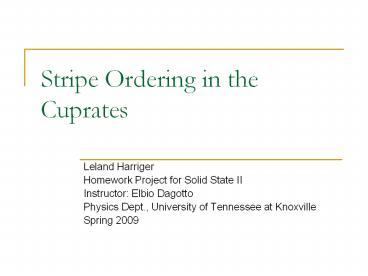Stripe%20Ordering%20in%20the%20Cuprates - PowerPoint PPT Presentation
Title:
Stripe%20Ordering%20in%20the%20Cuprates
Description:
Stripe Ordering in the Cuprates. Leland ... A periodic modulation of charge and spin. ... What does Stripe Ordering Mean for Superconductivity? References ... – PowerPoint PPT presentation
Number of Views:126
Avg rating:3.0/5.0
Title: Stripe%20Ordering%20in%20the%20Cuprates
1
Stripe Ordering in the Cuprates
- Leland Harriger
- Homework Project for Solid State II
- Instructor Elbio Dagotto
- Physics Dept., University of Tennessee at
Knoxville - Spring 2009
2
What is Stripe Ordering?
- A periodic modulation of charge and spin.
- Modulation of charge and spin are related by the
phase boundary. - Result Spin periodicity is twice that of charge
periodicity
3
Why does Stripe Ordering Occur?
4
The Distance that Separates.
5
Scattering Basics (Preclude to testing for stripe
ordering.)
6
Magnetic Scattering
7
Reciprocal Space of CuO4 in the Presence of
Stripe Ordering.
- Big Circles are nuclear Bragg peaks.
- Small plusses are magnetic Bragg peaks.
- Other symbols are incommensurate spreading of
peaks due to stripe ordering.
8
Estimate of d as a function of x.
9
Neutron Scattering
- The triple axis spectrometer is very versatile
for measurements of bulk solids. - Q-scans (ie momentum transfer)
- Both elastic and inelastic
- Typically performed at a fixed energy transfer.
- Energy Scans
- Set E0 for elastic scans
- Typically performed at a fixed Q.
10
What Proof do We have of Stripe Ordering?
11
What does Stripe Ordering Mean for
Superconductivity?
12
References
- 1 J. Orenstein, et. al Science 288, 468 (2000)
- J. Tranquada, et. al. Nature 375, 561
- J. Tranquada, et. al. Phys. Rev. Lett. 78, 338
- S. Chi, et. al. Phys. Rev. Lett. 102 107005
- Ph. Bourges, et. al. Physica C 424, 45
- Yamada K. et. al. Phys. Rev. B 57 6165

